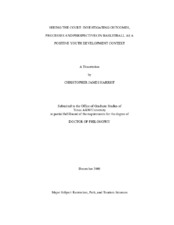| dc.contributor.advisor | Witt, Peter A. | |
| dc.creator | Harrist, Christopher J. | |
| dc.date.accessioned | 2010-07-23T21:46:39Z | |
| dc.date.accessioned | 2010-07-15T00:15:43Z | |
| dc.date.available | 2010-07-15T00:15:43Z | |
| dc.date.available | 2010-07-23T21:46:39Z | |
| dc.date.created | 2009-12 | |
| dc.date.issued | 2010-07-14 | |
| dc.date.submitted | December 2009 | |
| dc.identifier.uri | https://hdl.handle.net/1969.1/ETD-TAMU-2009-12-7536 | |
| dc.description.abstract | Researchers have found that 40 to 50 percent of youth's time can be classified as
free or residual, which yields great opportunities for their participation in leisure and
recreation activities. When all structured voluntary activities available to youth are
considered, the greatest amount of time is spent participating in youth sports. Organized
sports participation has been associated with positive developmental outcomes (e.g.,
healthier lifestyle; increases in self-efficacy; enhanced academic achievement); however,
not all experiences are positive. Research has found that the context of the activity
contributes significantly to participation being associated with positive or negative
outcomes. Understanding important contextual elements related to sports participation,
particularly as viewed by key stakeholders (e.g., coaches and players), is important in
developing quality experiences that promote beneficial growth.
The purpose of this study was to explore the potential of youth basketball as a
positive developmental context. More specifically, it examined: (1) the outcomes
associated with participation as identified by coaches of youth sport select teams; (2) the methods used by coaches to promote positive development; (3) the perceptions of the
players related to coaching intentions and behaviors; and (4) the fidelity with which
coaches carry out their identified coaching methods in practices and games.
Findings indicated that coaches and players were able to accurately identify
desired goals and methodologies along three domains: (1) player improvement; (2)
development of life skills; and (3) enjoying the playing experience. One outcome theme
showing inconsistency across the respondent groups was the identification of enjoying
the playing experience, which was not identified by the player group. This inconsistency,
however, did not show up when the respondents were identifying methodological
approaches. Further analysis of sub-themes indicated considerable variation between
coach and player responses. In addition, data obtained through observation corroborated
the major thematic findings; however, when discrepancies existed the data revealed
closer association to player responses. Player's also offered insight regarding personal
goals and positive developmental outcomes they attributed to participation.
Observational data also confirmed a portion of coach and player identified
methodologies, but new approaches were also discovered. | en |
| dc.format.mimetype | application/pdf | |
| dc.language.iso | eng | |
| dc.subject | coaching | en |
| dc.subject | youth basketball | en |
| dc.subject | qualitative | en |
| dc.subject | youth voice | en |
| dc.subject | youth sports | en |
| dc.subject | youth coaches | en |
| dc.subject | adolescent development | en |
| dc.subject | youth athletics | en |
| dc.subject | youth development | en |
| dc.subject | positive youth development | en |
| dc.title | Seeing the court: investigating outcomes, processes and perspectives in basketball as a positive youth development context | en |
| dc.type | Book | en |
| dc.type | Thesis | en |
| thesis.degree.department | Recreation, Park, and Tourism Sciences | en |
| thesis.degree.discipline | Recreation, Park, and Tourism Sciences | en |
| thesis.degree.grantor | Texas A&M University | en |
| thesis.degree.name | Doctor of Philosophy | en |
| thesis.degree.level | Doctoral | en |
| dc.contributor.committeeMember | Ash, Michael | |
| dc.contributor.committeeMember | Scott, David | |
| dc.contributor.committeeMember | Outley, Corliss | |
| dc.type.genre | Electronic Dissertation | en |
| dc.type.material | text | en |


